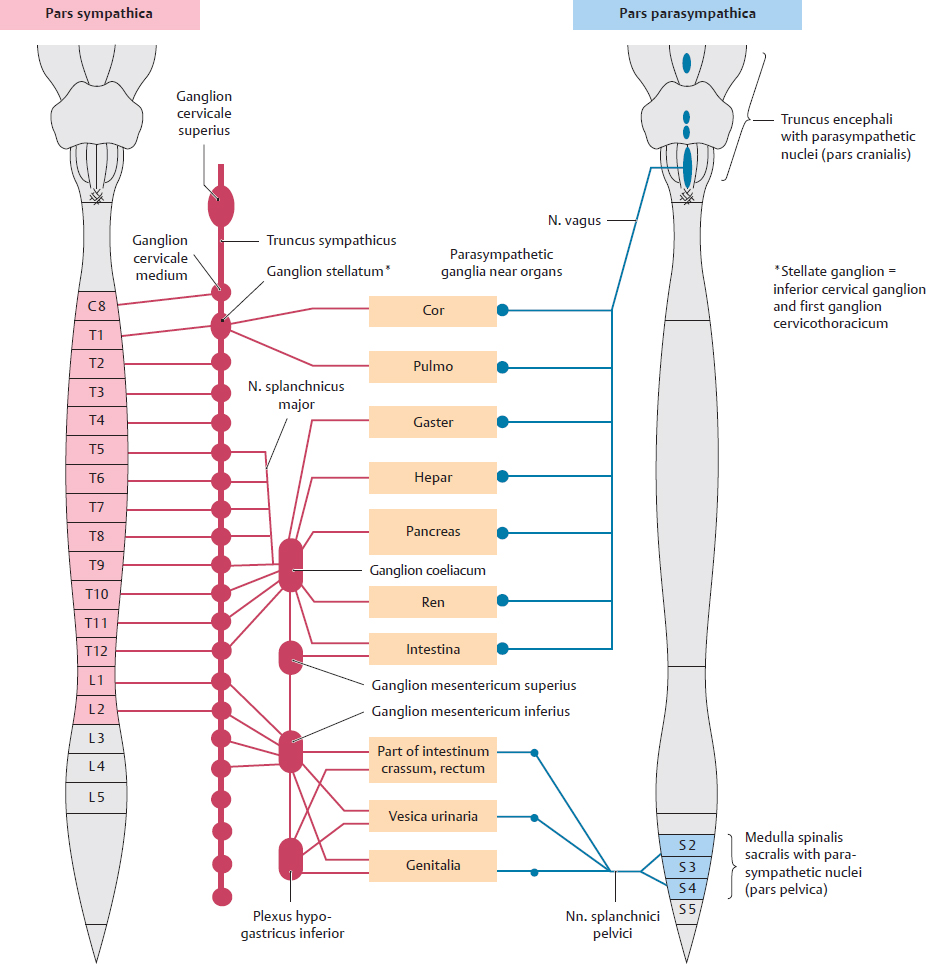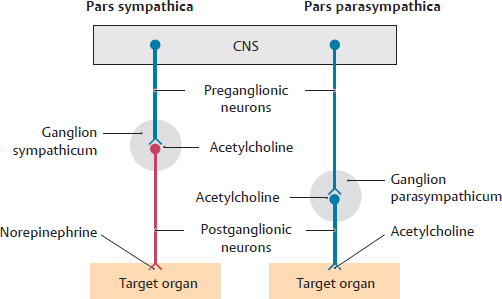9. Autonomic Nervous System The autonomic, or visceral nervous system innervates the internal organs. It is divided into three parts: the pars sympathica, pars parasympathica, and plexus entericus. For didactic reasons these systems are discussed separately; however, they represent one functional unit. A Structure of the pars sympathica (red) and pars parasympathica (blue) Both the partes sympathica and parasympathica utilize a two-neuron pathway between the CNS and their targets. The first neuron is called the preganglionic neuron, and the second neuron is the postganglionic neuron. The preganglionic sympathetic neurons are located in the cornu laterale of lower pars cervicalis, pars thoracica, and upper pars lumbalis of the medulla spinalis. The preganglionic parasympathetic neurons are located in nuclei nervorum cranialium and the pars sacralis of the medulla spinalis. The n. vagus, a n. cranialis, contains the preganglionic parasympathetic neurons that will innervate cervical, thoracic, and abdominal viscera. In both the partes sympathica and parasympathica, the preganglionic neurons of the CNS synapse with the postganglionic neurons in ganglia of the peripheral nervous system (see C and D). • In the pars sympathica of the nervous system, the preganglionic neuron synapses with the postganglionic neuron in ganglia of the truncus sympathicus (for trunk and limbs), in prevertebral ganglia (for viscera) or directly in the organs (only gll. suprarenales). • In the pars parasympathica of the nervous system, the n. vagus terminates at ganglia close to or in the walls (intramural ganglia) of the organs. According to Langley (1905), the terms pars sympathica and parasympathica originally referred only to efferent neurons and their axons (visceral efferent fibers, as shown above). It has now been shown that the partes sympathica and parasympathica contain afferent fibers (visceral afferent fibers, pain and stretch receptors not shown here, see p. 66). B Synopsis of the partes sympathica and parasympathica of the nervous system 1. The pars sympathica can be considered the excitatory part of the autonomic nervous system that prepares the body for a “fight or flight” response. 2. The pars parasympathica is the part of the autonomic nervous system that coordinates the “rest and digest” responses of the body. 3. Although there are separate control centers for the two divisions in the truncus encephali and medulla spinalis, they have close anatomic and functional ties in the periphery. 4. The principal transmitter at the target organ is acetylcholine in the pars parasympathica and norepinephrine in the pars sympathica. 5. Stimulation of the partes sympathica and parasympathica produces the following different effects on specific organs:
9.1 The Sympathetic and Parasympathetic Nervous Systems

Organ | Pars sympathica | Pars parasympathica |
Cor | Increased heart rate | Decreased heart rate |
Pulmones | Bronchodilation and decreased bronchial secretions | Bronchoconstriction and increased bronchial secretions |
Gastrointestinal tract | Decreased secretions and motor activity | Increased secretions and motor activity |
Pancreas | Decreased endocrine and exocrine secretions | Increased exocrine secretions |
Male genitalia | Ejaculation | Erection |




